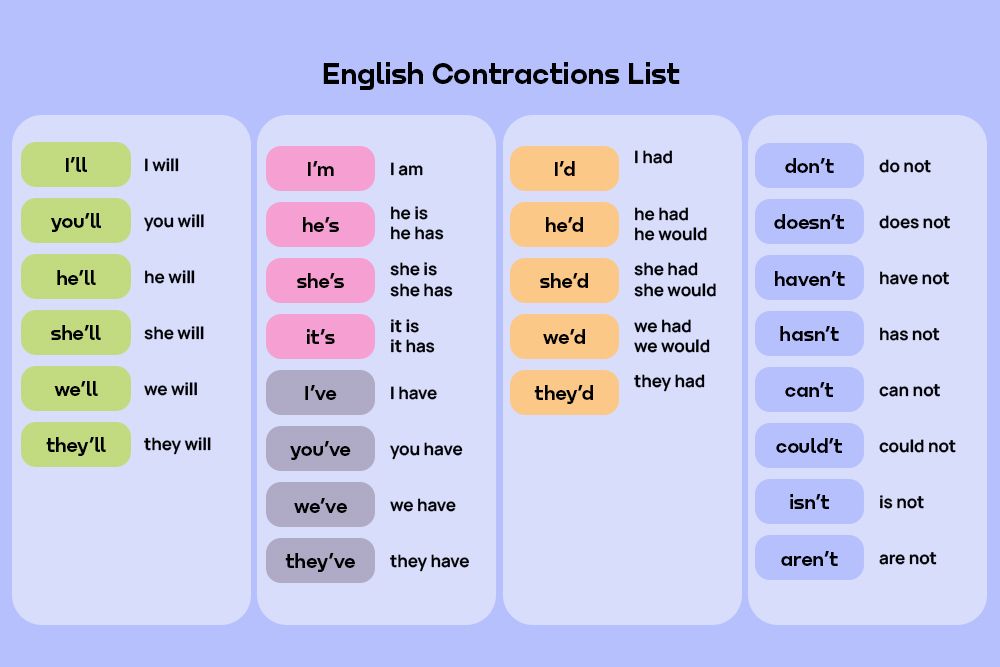What is a Contraction in English Grammar?

Contents
Do you fancy some music? Right before writing this article, we’ve been listening to this popular Bon Jovi song. Remember it? It’s my life, it’s now or never; I ain’t gonna live forever… You might think it has nothing to do with today’s topic, but it’s not true – only the first line of the chorus consists of four contractions. And what is a contraction in English grammar, you may ask? Please – make yourself comfortable. This article will provide all the information you need about this intriguing topic.
English contractions – in a nutshell

The Merriam-Webster Dictionary defines grammar contractions as shortenings of words, syllables, or even word groups by omitting certain letters or sounds and replacing them with an apostrophe. Basically, it means creating a new short form of two or more words. There are dozens of word contractions in the English language. Look at a few of the most popular ones:
- I/you/he/she/we/they + will = I’ll, you’ll, he’ll, she’ll, we’ll, they’ll;
- I + am = I’m;
- he/she + is = he’s, she’s;
- I/you/we/they + have = I’ve, you’ve, we’ve, they’ve;
- he/she/it + has = he’s, she’s, it’s;
- I/you/he/she/we/they + had/would = I’d, you’d, he’d, she’d, we’d, they’d;
- do/have/can/could/is/are + not = don’t/doesn’t, haven’t/hasn’t, can’t, couldn’t, isn’t, aren’t.
These are only a few examples of English contractions in grammar. Mostly, they are used in informal conversations or online dialogues. Nevertheless, some contractions might still be suitable even for formal circumstances. We will tell you about such exceptions later. And now, let’s find out what’s common and what’s different between contractions and other short forms of words – abbreviations.
Contraction vs. Abbreviation – what is the difference?
As we’ve just said, contractions and abbreviations are similar since they are both used to shorten words. Yet, that is probably the only thing they have in common. Contraction English grammar rules are pretty different from the abbreviation ones. Abbreviations are created by omitting letters from the end of the word, while contractions omit letters from the middle of the word or two words. Look at these examples:
- Abbreviations: vet (veterinarian), Prof. (professor), ext. (extension), etc. (et cetera), e.g. (exempli gratia/for example).
- Contractions: Dr. (doctor), St. (saint), Mr. (mister).
Another visible difference between these word-shortening forms is that contractions are mainly used in spoken language, while abbreviations are more appropriate in English writing. And now that you know how to tell the difference between them, let’s see the main types of contractions and their widespread examples.
Types of English contractions
Overall, we can divide English contractions into five main categories depending on their grammar construction or ways of use. There are formal and informal contractions (based on situations they are suitable for) and three types of grammar contractions based on the way they are created (subject + verb, interrogative adverbs + verb, verb + not). Let’s talk about each of them in more detail.
Subject + Verb
It is the most common type of English contraction. It is created by combining a pronoun (or sometimes a noun) with the verb. For example, when you combine the subjective pronoun I with the verb have, you create the contraction I’ve. Here are some more examples of such contractions in sentences:
I’ve been waiting for you for more than an hour. (I have been waiting for you.)
She’s the best dancer in the class. (She is the best dancer.)
They’re working in the garden. (They are working.)
I’ll see you later. (I will see you later.)
Interrogative adverbs + Verb
Here is another popular example of contractions in English grammar. You can combine interrogative adverbs with verbs while making the questions to create contractions. Some of such phrases are established (What’s up?), and others are just widespread among native speakers. For example:
What’s the matter with you? (What is the matter with you?)
Where’s Jack? (Where is Jack?)
Who’s on duty today? (Who is on duty today?)
Why’s he staring at me? (Why is he staring at me?)
Verb + not
The last grammar type of contractions in English words is negative contractions. They are created by combining modal verbs with the particle not. The short form of it is usually made by omitting the letter o and replacing it with the apostrophe. For example:
I don’t want to go there. (I do not want to go there.)
She isn’t here. (She is not here.)
I couldn’t help you. (I could not help you.)
You shouldn’t go there. (You should not go there.)
Formal contractions
Now that you know what a contraction is in English and its grammar types, it is time to learn the difference between formal and informal usage of such short words. Firstly, let’s talk about formal contractions. Mainly, they are used in letters. It is usually a short form of address (Mr., Mrs., Dr.) or names of days and months (Wed, Feb, Sat). For example:
Dear Mrs. Smith.
I will send your CV to Dr. Johnson as soon as possible.
Informal Contractions
Probably the most widespread types of contractions are the informal ones. They are extremely popular among native speakers since they significantly simplify your speech and allow you to share your thoughts quickly. Here is the list of the most popular informal contraction English grammar examples:
- Give + me = Gimme. Gimme some bread, please. Gimme, gimme, gimme a man after midnight.
- I am going to = Imma. Imma throw up right now. Imma give you the word.
- You + all = Y’all. Thank y’all for being here. I appreciate y’all’s attention.
- Got + to = Gotta. I’ve gotta go, sorry. I’ve gotta get my mum from the airport.
- Let + us = Let’s. Let’s start our meeting. Let’s go.
There are also many established informal ways of using the contraction in writing and speaking. For example, did you know that one of the most widespread contractions is the word o’clock? Initially, it is a contraction of the phrase “of the clock.” As you can see, some letters were replaced with an apostrophe to simplify the pronunciation.
The most confusing contraction words
Congratulations! Now you know almost everything about English contractions. And it is a really simple topic – all you have to do is learn how to create them and when it is appropriate to use them. Yet, some people still get confused about this topic. Let’s take a look at the most common mistakes you can face.
If you read the Promova blog frequently, you already know that many words in English are spelled differently but pronounced the same. And if you don’t know what contractions are in writing or how to use them, you can be confused by some of these words. Look at the most common examples:
- Its and it’s.
Here is the first pair of words that sound the same but have completely different meanings. The word “its” is the possessive form of the word “it,” and “it’s” is a short form for “it is.” You can easily see the difference from the context:
You should take an umbrella. It’s raining outside. (It is raining outside.)
This dress is worth its price.
- Your and you’re.
Even Rachel Green herself had confused these two words while writing her famous letter to Ross (yes, the one with eighteen pages. Front and back!). And it is easy to make such a mistake since these words sound the same. But have to remember that you’re is the contraction of you are, and your is the possessive form of you. For example:
I can’t believe you’re working with Joseph.
Your mother is always so kind to me.
- Won’t (not willn’t).
This contraction is also tricky. Even though it is a short form of will not, you can’t find the reflection of the word will in this contraction. The reason for it is simple. Four hundred years ago, people used the negative form wonnot instead of will not. That is how this contraction appeared. Although now the word wonnot is considered outdated, its short form is still widespread.
I won’t go with you.
She won’t be here in time.
- Who’s and whose.
The last example of contraction mistakes today is the words who’s and whose. As you’ve already guessed, most people get this one wrong also due to the similar pronunciation. And again, the difference is simple. “Who’s” is the short form of who is, and whose is the possessive form of “who.”
Who’s this? (Who is this?)
Whose dress are you wearing?
6
How can Promova help you to master contractions’ grammar and more?
Even though learning English contractions might be a piece of cake, some grammar rules and exceptions can be challenging, even for the most prominent students. But you don’t have to worry! We have a perfect solution for you. We are pleased to introduce you to Promova – an online language-learning platform that has everything you could possibly need in your studying journey.
Still don’t know what a contraction is in writing? Don’t worry. Our team of professional tutors is ready to help you in both personal and group lessons. Visit the platform’s official website, pass a quick test to determine your language level, and choose the option that suits you best. And don’t forget about our free Conversation Club. Here you can practice your speaking, discuss interesting topics, and meet people from around the world.
Promova also has something great for those who prefer studying alone. Remember these simple steps – take your phone, go to the App Store or Play Market, and install a modern and convenient Promova app. You will immediately access hundreds of interesting topics and will be able to learn them anywhere and anytime you want.
Conclusion
As you can see, there are countless contractions in English. Most of them you’ve used even before reading this article. But now you know exactly what they are, how to make them, and how to implement them in your daily conversations. We hope that this article was helpful and are already looking forward to sharing more language tips with you. But before we prepare them, feel free to share your thoughts about grammar contractions in the comments!
FAQ
What are English contractions?
According to the Oxford Learner’s Dictionary, a contraction is simply a short form of a word. Basically, it is a word that was created by combining two existing words and replacing some letters with an apostrophe. The most common contractions are I’m (short for I am), he’s/she’s (he is/she is, or he has/she has), and don’t (short for do not).
Why is it important to learn English contractions?
Contractions are an integral part of English, like any other grammar constructions. Therefore, it is important to learn them for several reasons. Firstly, since they are short forms of words, they allow you to express your thoughts and speak quickly. Another reason is that understanding contractions prevents confusion and misunderstandings during communication with natives.
What are the types of contractions in English?
There are five main types of English contractions. The first three differ by the ways of creating them – there are short forms of subjects + verbs (he’s, you’ll, I’m), interrogative adverbs + verbs (who’s, where’s), and modal verbs + not (don’t, can’t, won’t). Contractions can also be formal (Ms., Mrs., Dr.) and informal (y’all, gimme).
What are the informal contractions in English?
Informal contractions are the ones suitable only for casual conversations or informal correspondence. They are mostly used by native speakers during online messaging or communication with family or friends. The most popular examples of informal contractions are gimme (give me), lemme (let me), ain’t (is not, has not), let’s (let us), Imma (I am going to) and more.
Comments